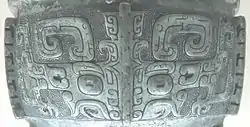饕餮
Chinese
| gluttonous | gluttonous | ||
|---|---|---|---|
| trad. (饕餮) | 饕 | 餮 | |
| simp. #(饕餮) | 饕 | 餮 | |

饕餮 (taotie motif)
Pronunciation
Noun
饕餮
- (Chinese mythology) taotie (legendary gluttonous animal)
- (~紋) taotie (stylized design frequently found on ancient bronzes)
- (figurative) gourmand; glutton; voracious eater
- (figurative) fierce and greedy person
Derived terms
|
|
Japanese
| Kanji in this term | |
|---|---|
| 饕 | 餮 |
| とう Hyōgaiji | てつ Hyōgaiji |
| on’yomi | |
Noun
饕餮 • (tōtetsu)
- a taotie
- (figuratively) a brutal or covetous person
Derived terms
- 饕餮文 (tōtetsumon)